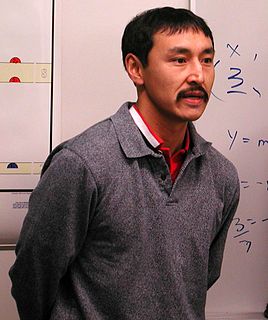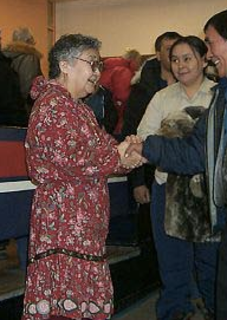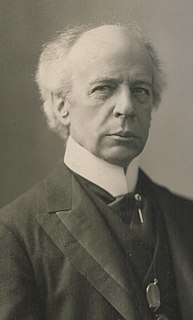Devolution is the statutory delegation of powers from the central government of a sovereign state to govern at a subnational level, such as a regional or local level. It is a form of administrative decentralization. Devolved territories have the power to make legislation relevant to the area.

Paul Okalik is a Canadian politician. He is the first Inuk member to have been called to the Nunavut Bar and the first Premier of Nunavut.

Nunavut is a federal electoral district in Nunavut, Canada, that has been represented in the House of Commons of Canada since 1979. Before 1997, it was known as Nunatsiaq, and was one of two electoral districts in Northwest Territories.

Inuktitut, also Eastern Canadian Inuktitut, is one of the principal Inuit languages of Canada. It is spoken in all areas north of the tree line, including parts of the provinces of Newfoundland and Labrador, Quebec, to some extent in northeastern Manitoba as well as the Northwest Territories and Nunavut. It is one of the aboriginal languages written with Canadian Aboriginal syllabics.

Helen Mamayaok Maksagak, was a Canadian politician. She served as the Commissioner of the Northwest Territories (Canada) from January 16, 1995 until March 26, 1999 and as the Commissioner of Nunavut from April 1, 1999 until April 1, 2000. She is a notable Copper Inuk.

The Canadian federal election of 1908 was held on October 26 to elect members of the House of Commons of Canada of the 11th Parliament of Canada. Prime Minister Sir Wilfrid Laurier's Liberal Party of Canada was re-elected for a fourth consecutive term in government with a majority government. The Liberals lost four seats and a small share of the popular vote.

The history of Northwest Territories capital cities begins with the purchase of the Territories by Canada from the Hudson's Bay Company in 1869, and includes a varied and often difficult evolution. Northwest Territories is unique amongst the other provinces and territories of Canada in that it has had seven capital cities in its history. The territory has changed the seat of government for numerous reasons, including civil conflict, development of infrastructure, and a history of significant revisions to its territorial boundaries.
The Northwest Territories division plebiscite was a stand-alone territory wide plebiscite conducted on April 14, 1982. This was the first territory wide plebiscite conducted in Northwest Territories history. The results of the plebiscite would eventually lead to the creation of Nunavut, and spawn three other plebiscites during the creation process of the new territory.
The Tunngavik Federation of Nunavut was the organization officially recognized from 1982 to 1993 as representing the Inuit of what is now Nunavut, but was then part of the Northwest Territories, for the purpose of negotiating treaties and land claims settlements. In this role, it replaced the Inuit Tapiriit Kanatami, which represents Inuit across Canada, and has been superseded by Nunavut Tunngavik Incorporated.
Nunavut Tunngavik Incorporated is the legal representative of the Inuit of Nunavut for the purposes of native treaty rights and treaty negotiation. The presidents of NTI, Makivik Corporation, Nunatsiavut, and the Inuvialuit Regional Corporation, the four regional land claims organizations, govern the national body, the Inuit Tapiriit Kanatami (ITK) as its board of directors. NTI continues to play a central role in Nunavut, even after the creation of the Government of Nunavut. As the successor of the Tunngavik Federation of Nunavut, which was a signatory of the Nunavut Land Claims Agreement on behalf of Inuit, NTI is responsible for ensuring that the Nunavut Land Claims Agreement is implemented fully by the Government of Canada and the Government of Nunavut and that all parties fulfill their obligations.

Lancaster Sound is a body of water in the Qikiqtaaluk Region, Nunavut, Canada. It is located between Devon Island and Baffin Island, forming the eastern entrance to the Parry Channel and the Northwest Passage. East of the sound lies Baffin Bay; to the west lies Viscount Melville Sound. Further west a traveller would enter the M'Clure Strait before heading into the Arctic Ocean.
Tagak Curley is an Inuit leader, politician and businessman from Nunavut. As a prominent figure in the negotiations that led to the creation of Nunavut, Tagak is considered a living father of confederation in Canada. He was born in a hunting camp at Coral Harbour, Northwest Territories.

The history of Canada (1992–present) refers to the period immediately following the end of the Cold War, until present.
The region now known as Nunavut has supported a continuous population for approximately 4000 years. Most historians also identify the coast of Baffin Island with the Helluland described in Norse sagas, so it is possible that the inhabitants of the region had occasional contact with Norse sailors.
The Nunavut Land Claim Agreement was signed on May 25, 1993, in Iqaluit, by representatives of the Tunngavik Federation of Nunavut, the Government of Canada and the Government of the Northwest Territories. This agreement gave the Inuit of the central and eastern Northwest Territories a separate territory called Nunavut. It is the largest Aboriginal land claim settlement in Canadian history. The NLCA consists of 42 chapters, which addressing a broad range of political and environmental rights and concerns including wildlife management and harvesting rights, land, water and environmental management regimes, parks and conservation areas, heritage resources, public sector employment and contracting, and a range of other issues. The agreement indicates two areas that are the focus of the agreement: the first area consists of the Arctic islands and the mainland eastern Arctic, and their adjacent marine areas; the second area includes the Belcher Islands, its associated islands and adjacent marine areas.
A referendum on the creation of the territory of Nunavut was held between 3 and 5 November 1992 in the territory set to become the new territory. It was approved by 69% of voters. On 25 May 1993 the Mulroney government and the TFN signed the Nunavut Agreement. On 10 June 1993 the federal Parliament passed two laws dividing the Northwest Territories and providing for the formation of Nunavut on 1 April 1999.
Indigenous or Aboriginal self-government refers to proposals to give governments representing the Indigenous peoples in Canada greater powers of government. These proposals range from giving Aboriginal governments powers similar to that of local governments in Canada to demands that Indigenous governments be recognized as sovereign, and capable of "nation-to-nation" negotiations as legal equals to the Crown, as well as many other variations.









